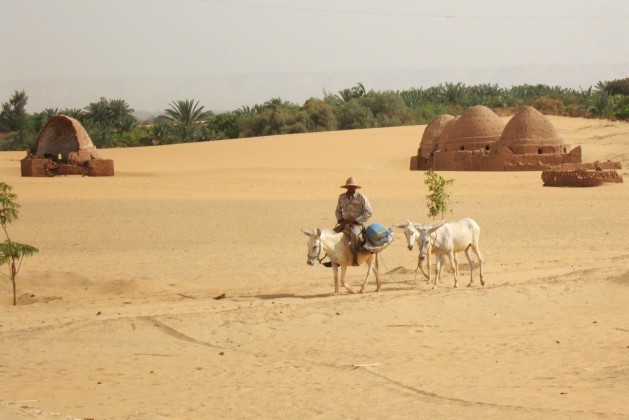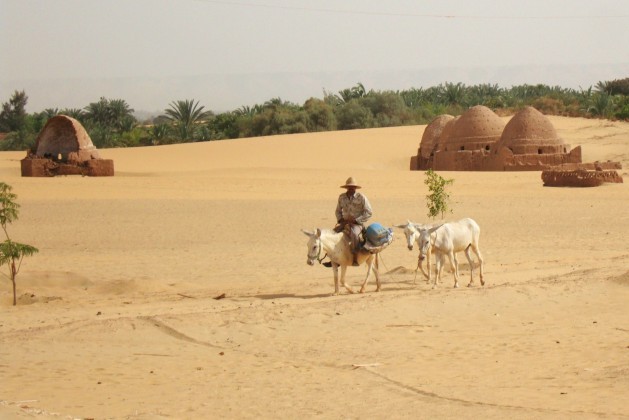By Baher Kamal | (Inter Press Service) | – –
ROME (IPS) – New evidence is deepening scientific fears, advanced few years ago, that the Middle East and North Africa risk becoming uninhabitable in a few decades, as accessible fresh water has fallen by two-thirds over the past 40 years.

The water table is falling in Egypt’s desert oases, raising questions of sustainability. Credit: Cam McGrath/IPS
This sharp water scarcity simply not only affects the already precarious provision of drinking water for most of the region’s 22 countries, home to nearly 400 million inhabitants, but also the availability of water for agriculture and food production for a fast growing population.
“Looming water scarcity in the North Africa and Middle East region is a huge challenge requiring an urgent and massive response” – Graziano da Silva.
The new facts are stark: per capita availability of fresh water in the region is now 10 times less than the world average. Moreover, higher temperatures may shorten growing seasons in the region by 18 days and reduce agricultural yields a further 27 per cent to 55 per cent less by the end of this century.
Add to this that the region’s fresh water resources are among the lowest in the world, and are expected to fall over 50 per cent by 2050, according to the United Nations leading agency in the field of food and agriculture.
Moreover, 90 per cent of the total land in the region lies within arid, semi/arid and dry sub/humid areas, while 45 per cent of the total agricultural area is exposed to salinity, soil nutrient depletion and wind water erosion, adds the UN Food and Agriculture Organization (FAO).
Meanwhile, agriculture in the region uses around 85 per cent of the total available freshwater, it reports, adding that over 60 per cent of water resources in the region flows from outside national and regional boundaries.
This alarming situation has prompted FAO’s director general to call for urgent action. On his recent visit to Cairo, Jose Graziano da Silva said that access to water is a “fundamental need for food security, human health and agriculture”, and its looming scarcity in the North Africa and Middle East region is a huge challenge requiring an “urgent and massive response”.
Meantime, the rising sea level in the Nile Delta –which hosts the most fertile lands in Egypt– is exposing the region’s most inhabited country (almost 100 million people) to the danger of losing substantial parts of the most productive agriculture land due to salinisation.
“Competition between water-usage sectors will only intensify in the future between agriculture, energy, industrial production and household needs,” on March 9 warned Graziano da Silva.
FAO’s chief attended in Cairo a high-level meeting on the Rome-based organisation’s collaboration with Egypt on the “1.5 million feddan initiative” {1 feddan is equivalent to 0.42 hectares, or 1.038 acres}, the Egyptian government’s plan to reclaim eventually up to two million hectares of desert land for agricultural and other uses.
What to Do?
Egypt’s future agenda is particularly tough as the country “needs to look seriously into the choice of crops and the patterns of consumption,” Graziano da Silva also warned, pointing to potential water waste in cultivating wheat in the country.
“Urgent actions supporting it include measures aimed at reducing food loss and waste and bolstering the resilience of smallholders and family farmers, that require implementing a mix of social protection interventions, investments and technology transfers.”
Specialty crops such as fruit and vegetables, here on sale at a Cairo market, have a key role in Egypt’s future. Credit: FAO
Specialty crops such as fruit and vegetables, here on sale at a Cairo market, have a key role in Egypt’s future. Credit: FAO
The UN specialised agency leads a Near East and North Africa Water Scarcity Initiative that provides both policy advice and best practice ideas on the governance of irrigation schemes. The Initiative is now backed by a network of more than 30 national and international organisations.
The Big Risk
Several scientific studies about ongoing climate change impact on the Middle East region, particularly in the Gulf area, had already sounded loud warning drums.
“Within this century, parts of the Persian Gulf region could be hit with unprecedented events of deadly heat as a result of climate change, according to a study of high-resolution climate models,” a Massachusetts Institute of Technology (MIT) research said.
The research–titled “Persian Gulf could experience deadly heat”, reveals details of a business-as-usual scenario for greenhouse gas emissions, but also shows that curbing emissions could forestall these “deadly temperature extremes.”
The study, which was published in detail ahead of the Paris climate summit in the journal Nature Climate Change, was conducted by Elfatih Eltahir, a professor of civil and environmental engineering at MIT, and Jeremy Pal of Loyola Marymount University.
The authors conclude that conditions in the Persian Gulf region, including its shallow water and intense sun, make it “a specific regional hotspot where climate change, in absence of significant mitigation, is likely to severely impact human habitability in the future.”
Running high-resolution versions of standard climate models, Eltahir and Pal found that many major cities in the region could exceed a tipping point for human survival, even in shaded and well-ventilated spaces. Eltahir says this threshold “has, as far as we know … never been reported for any location on Earth.”
For its part, the IPCC – Intergovernmental Panel on Climate Change latest assessment warns that the climate is predicted to become even hotter and drier in most of the Middle East and North of Africa region.
Higher temperatures and reduced precipitation will increase the occurrence of droughts, an effect that is already materializing in the Maghreb,” said the World Bank while citing the IPCC assessment.



 © 2025 All Rights Reserved
© 2025 All Rights Reserved